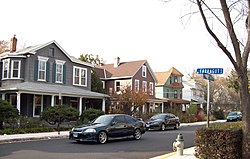
Hyattsville is a city in Prince George's County, Maryland, United States, and also a close, urban suburb of Washington, D.C. The population was 21,187 at the 2020 United States Census.
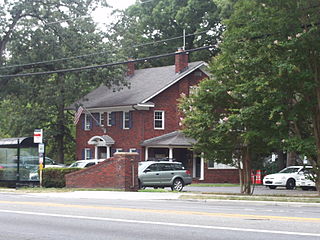
University Park is a town in Prince George's County, Maryland, United States. The population was 2,548 at the 2010 census.

University Town Center, formerly New Town Center, is located in Hyattsville, Prince George's County, Maryland, United States. It was a planned urban center designed by Edward Durell Stone and located on a 105-acre (0.42 km2) parcel at the intersection of Belcrest Road and East-West Highway and across from the then new Prince George's Plaza. The initial construction on this development took place in 1963-64; its buildings are listed on the National Register of Historic Places. A second phase commenced after the opening of the Prince George's Plaza station, Washington Metro rapid transit station in 1993.
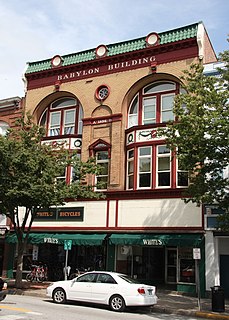
The Westminster Historic District comprises the historic center of Westminster, Maryland. The district includes about 1400 structures, with a high proportion of contributing structures. The town exhibits a variety of building styles and notable examples of Greek Revival, Georgian, and Gothic Revival style architecture. Most of the structures exhibit early 19th-century residential vernacular architecture and mid-19th century commercial architecture.
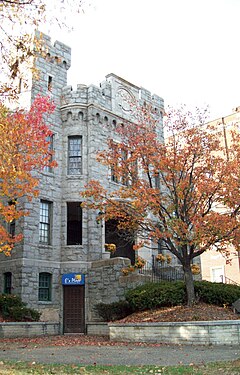
The Hyattsville Armory is a historic National Guard armory built in 1918 and located in Hyattsville, Prince George's County, Maryland, United States. It was the first Armory built in Prince George's County and the fifth in Maryland. Its architect, Robert Lawrence Harris, served as State Architect under Governor Albert C. Ritchie. In this capacity, Harris supervised the design of similar armories in Salisbury, Kensington, Silver Spring, Hagerstown, Laurel, Easton, Crisfield, Pocomoke City, Centreville, and Cumberland. The structure is distinctly fortresslike and offers a commanding view of the surrounding area. The building is patterned after a medieval English castle and built of native stone, with rectangular turrets flanking the arched limestone entranceway. Carved above the entry is the State Seal of Maryland.
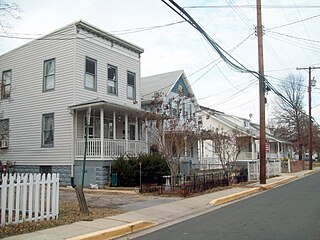
The North Brentwood Historic District, is a national historic district located in the town of North Brentwood, Prince George's County, Maryland. It was the earliest incorporated African American community in the county. The historic district comprises 128 buildings reflecting its development over the period from 1891 to 1950. All of the early vernacular dwellings were of wood-frame construction with Late Victorian inspiration. The 1920s house forms represented included bungalows, multi-family houses, and larger Foursquares. Small brick cottages were primarily built in the period immediately following World War II. The surviving historic buildings illustrate the forms and styles of buildings typically constructed in working-class suburban communities of the period.
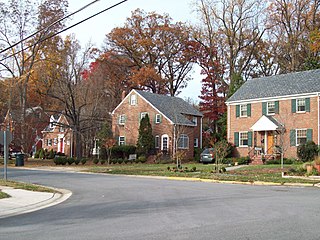
The University Park Historic District is a national historic district located in the town of University Park, Prince George's County, Maryland. The district encompasses 1,149 contributing buildings and 2 contributing sites and is almost exclusively residential and developed as a middle-class, automobile suburb of Washington, D.C. The primary building type is the detached single-family dwelling, with the only non-residential buildings within the district and the town being two churches and the Town Hall, which is located in a former residence. Notable features within the district include the property's original plantation house, known as Bloomfield, and the nearby family cemetery. It was developed over the period 1920 to 1945, and houses are built in a range of popular early-20th-century architectural styles including Tudor and Mediterranean Revival, and varied interpretations of the Craftsman Aesthetic and the Colonial Revival, including interpretations of Dutch, Georgian, and Federal period substyles.

The Riverdale Park Historic District is a national historic district located at Riverdale Park, Prince George's County, Maryland. The community developed starting in 1889, around the B & O passenger railroad station, as an early railroad suburb northeast of Washington, D.C. Later, 20th century additions expanded the community. One of the more imposing features of the community is the early-19th-century mansion known as Riversdale. In general residential styles range from large 2+1⁄2-story wood-frame dwellings to smaller bungalows, with an eclectic collection of imposing Queen Anne and Colonial Revival houses.

The Washington Street Historic District is a national historic district named after George Washington in Cumberland, Allegany County, Maryland. It is an approximately 35-acre (140,000 m2) residential area to the west of downtown Cumberland and consists primarily of six blocks of Washington Street. It contains large-scale 19th- and 20th-century houses representing most of the major architectural styles, including examples of Greek Revival, Italianate, Gothic, Queen Anne, Romanesque, Colonial Revival, and bungalow. Also included in the district are the 1890s Romanesque courthouse, the 1850s Greek Revival academy building, and the Algonquin Hotel. It was listed on the National Register of Historic Places in 1973.

The Lonaconing Historic District is a national historic district in Lonaconing, Allegany County, Maryland. It comprises 278 buildings and structures consisting of a variety of 19th and early-20th century commercial, industrial, and residential buildings. These structures identify with the development of Lonaconing as a center of the iron, coal, and silk industries in the George's Creek Valley of Western Maryland. It includes a group of 40 late-19th and early-20th century brick or frame commercial structures, including a hotel, bank, three dry goods stores, and numerous other shops and warehouses, mostly constructed after a fire which devastated downtown in 1881.

The Pocomoke City Historic District is a national historic district in Pocomoke City, Worcester County, Maryland. The historic district includes the central business district (CBD) and surrounding residential area of Pocomoke City. The CBD is defined by an important collection of late-19th century and early-20th century commercial and public architecture. It includes a significant array of Victorian, Colonial Revival, and Beaux-Arts influenced structures. The majority of the housing dates from 1870 to 1940. It is an example of a type of prosperous river town that characterized the region during the period, which retains an exceptional collection of 19th and 20th century building forms.

The Mount Airy Historic District is a national historic district in Mount Airy, located in Carroll and Frederick County, Maryland. The district comprises a cohesive group of commercial, residential, and ecclesiastical buildings dating from the late 19th through early 20th centuries. The brick Baltimore and Ohio Railroad station, designed by E. Francis Baldwin and constructed in 1882, represents the town's origin as an early transportation center for the region, which dates back as early as 1838. A group of early-20th century commercial structures represent the rebuilding of Mount Airy's downtown after a series of fires between 1903 and 1926. The residential areas are characterized by houses illustrating vernacular forms and popular stylistic influences of the late 19th and early 20th century. Three churches are located within the district.

Market Center is a national historic district in Baltimore, Maryland, United States. It is an approximately 24-block area in downtown Baltimore that includes buildings associated with the development of the area as Baltimore's historic retail district. The area evolved from an early 19th-century neighborhood of urban rowhouses to a premiere shopping district featuring large department stores, grand theaters, and major chain stores. The diverse size, style, scale, and types of structures within the district reflect its residential origins and evolution as a downtown retail center.
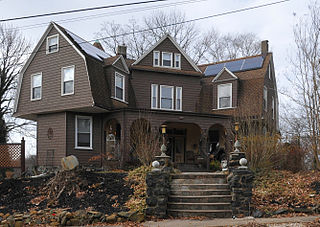
Windsor Hills Historic District is a national historic district in Baltimore, Maryland, United States. It is a cohesive residential suburb defined by rolling topography, winding, picturesque streets, stone garden walls, walks and private alley ways, early-20th century garden apartments, duplexes, and freestanding residences. Structures are predominantly of frame construction with locally quarried stone foundations. Windsor Hills developed over a period from about 1895 through 1929. The dominant styles include Shingle cottages, Dutch Colonial Revival houses, Foursquares, and Craftsman Bungalows.

Arcadia–Beverly Hills Historic District is a national historic district in Baltimore, Maryland, United States. It is a cohesive residential suburb comprising approximately 30 irregularly shaped blocks containing some 900 buildings. They are primarily freestanding masonry and frame houses set back from the streets with small front yards. Early-20th century suburban architectural styles represented in the district include foursquare, bungalows, early suburban villas, Colonial Revival, Tudor Revival, and Pueblo Revival. Also included are two churches, a 45-acre (180,000 m2) cemetery, and a variety of commercial buildings along Harford and Belair Roads. Herring Run Park provides a wooded park setting for the community. The earliest structure in the community was constructed in 1887, and the district had substantially achieved its existing form and appearance by 1950.

Old Catonsville Historic District is a national historic district in Catonsville, Baltimore County, Maryland, United States. It was laid out with the construction of the electric railway and is overwhelmingly residential, with three churches, a modern public library, and an Art Deco water tower. Architectural styles in the district range from mid- to late-19th century vernacular "I-houses" to late-19th and early-20th century styles such as Queen Anne, Bungalow, Colonial Revival, Dutch Colonial, Tudor Revival, and Craftsman. A large number of these dwellings have freestanding garages, typically finished in a like manner to their houses.

Green Spring Valley Historic District is a national historic district near Stevenson in Baltimore County, Maryland, United States. It is a suburban area of Baltimore that acquires significance from the collection of 18th, 19th, and early 20th century buildings. The park-like setting retains a late 19th-early 20th century atmosphere. At the turn of the 20th century, the Maryland Hunt Cup and the Grand National Maryland steeplechase races were run over various parts of the valley. The Maryland Hunt Cup, which began as a competition between the Green Spring Valley Hunt and the Elkridge Hunt, traditionally started at Brooklandwood, the previous home of Charles Carrol of Carrollton with the finish across Valley Road at Oakdene, at that time the home of Thomas Deford, which remains a private residence

Williamsport Historic District is a national historic district at Williamsport, Washington County, Maryland, United States. The district consists of the historic core of this town. Almost 20 percent of the buildings in the district date from the late 18th and early 19th centuries. They are generally of log or brick construction until the second quarter of the 19th century. The town grew with the Chesapeake and Ohio Canal and railroads, which resulted in prominent late 19th century Italianate and Queen Anne style buildings for residential and commercial purposes. Slightly less than 60 percent of the buildings date from the late 19th and early 20th centuries.
Potomac–Broadway Historic District is a national historic district at Hagerstown, Washington County, Maryland, United States. The district is located in the north downtown area and consists largely of a late 19th and early 20th century residential area with most buildings dating from 1870 to 1930. Architectural styles represented include Victorian Gothic, Queen Anne, Colonial Revival, and American Foursquare.

South Prospect Street Historic District is a national historic district at Hagerstown, Washington County, Maryland, United States. The district is a 19th and early 20th century residential neighborhood which was once the address of many of Hagerstown's leading citizens. The street is lined with more than 50 structures representing America's varied and strong architectural heritage and includes both domestic and ecclesiastical buildings, such as Saint John's Church and the Presbyterian Church. The architectural styles represented range from the Neoclassical of the early 19th century to the classical revivals of the early 20th century.
